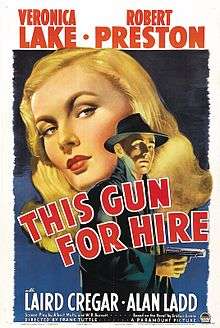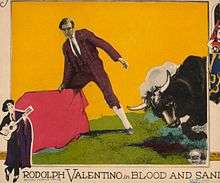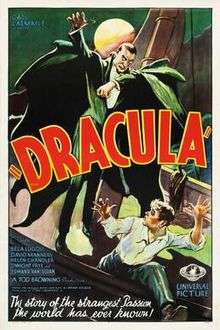Film poster

A film poster is a poster used to promote and advertise a film. Studios often print several posters that vary in size and content for various domestic and international markets. They normally contain an image with text. Today's posters often feature photographs of the main actors. Prior to the 1990s, illustrations instead of photos were far more common. The text on film posters usually contains the film title in large lettering and often the names of the main actors. It may also include a tagline, the name of the director, names of characters, the release date, etc.
Film posters are displayed inside and on the outside of movie theaters, and elsewhere on the street or in shops. The same images appear in the film exhibitor's pressbook and may also be used on websites, DVD (and historically VHS) packaging, flyers, advertisements in newspapers and magazines, etc.
Film posters have been used since the earliest public exhibitions of film. They began as outside placards listing the programme of (short) films to be shown inside the hall or movie theater. By the early 1900s, they began to feature illustrations of a film scene or an array of overlaid images from several scenes. Other posters have used artistic interpretations of a scene or even the theme of the film, represented in a wide variety of artistic styles.
History


Originally, film posters were produced for the exclusive use by the theaters exhibiting the film the poster was created for, and were required to be returned to the distributor after the film left the theater. In the United States, film posters were usually returned to a nationwide operation called the National Screen Service (NSS) which printed and distributed most of the film posters for the studios between 1940 and 1984. As an economy measure, the NSS regularly recycled posters that were returned, sending them back out to be used again at another theater. During this time, a film could stay in circulation for several years, and so many old film posters were badly worn before being retired into storage at an NSS warehouse (most often, they were thrown away when they were no longer needed or had become too worn to be used again). Those posters which were not returned were often thrown away by the theater owner, but some found their way into the hands of collectors.
Beginning in the 1980s, the American film studios began taking over direct production and distribution of their posters from the National Screen Service and the process of making and distributing film posters became decentralized in that country.
Collecting


After the National Screen Service ceased most of its printing and distribution operations in 1985, some of the posters which they had stored in warehouses around the United States ended up in the hands of private collectors and dealers. Today there is a thriving collectibles market in film posters; some have become very valuable. The first auction by a major auction house solely of film posters occurred on December 11, 1990, when proceeds of a sale of 271 vintage posters run by Bruce Hershenson at Christie's totaled US $935,000.[1][2] The record price for a single poster was set on November 15, 2005 when $690,000 was paid for a poster of Fritz Lang's 1927 film Metropolis from the Reel Poster Gallery in London.[3] Other early horror and science fiction posters are known to bring extremely high prices as well, with an example from The Mummy realizing $452,000 in a 1997 Sotheby's auction,[3] and posters from both Bride of Frankenstein and The Black Cat selling for $334,600 in Heritage auctions, in 2007 and 2009, respectively.[4]

Occasionally, rare film posters have been found being used as insulation in attics and walls. In 2011, 33 film posters, including a Dracula Style F one-sheet (shown right), from 1930-1931 were discovered in an attic in Berwick, Pennsylvania and auctioned for $502,000 in March 2012 by Heritage Auctions.[5]
Over the years, old Bollywood posters, especially with hand-painted art, have become collectors items.[6][7][8]
As a result of market demand, some of the more popular older film posters have been reproduced either under license or illegally. Although the artwork on reproductions is the same as originals, reproductions can often be distinguished by size, printing quality, and paper type. Several websites on the Internet offer "authentication" tests to distinguish originals from reproductions.
Original film posters distributed to theaters and other poster venues (such as bus stops) by the movie studios are never sold directly to the public. However, most modern posters are produced in large quantities and often become available for purchase by collectors indirectly through various secondary markets such as eBay. Accordingly, most modern posters are not as valuable. However some recent posters, such as the Pulp Fiction "Lucky Strike" U.S. one sheet poster (recalled due to a dispute with the cigarette company), are quite rare.[9]
Types
Lobby cards

Lobby cards are similar to posters but smaller, usually 11 in × 14 in (28 cm × 36 cm), also 8 in × 10 in (20 cm × 25 cm) before 1930. Lobby cards are collectible and values depend on their age, quality, and popularity. Typically issued in sets of eight, each featuring a different scene from the film. In unusual circumstances, some releases were promoted with larger (12 cards) or smaller sets (6 cards). The set for The Running Man (1963), for example, had only six cards, whereas the set for The Italian Job (1969) had twelve. Films released by major production companies experiencing financial difficulties often lacked lobby sets, such as Manhunter (1986).
A Jumbo Lobby Card is larger, 14 in x 17 in (36 cm x 45 cm) and also issued in sets. Prior to 1940 studios promoted major releases with the larger card sets. In addition to the larger size, the paper quality was better (glossy or linen). A jumbo lobby card set does not contain a title card. The title card displays the movie title and top stars prominently.[10]
In the United Kingdom, sets of lobby cards are known as "Front of House" cards. These, however, also refer to black-and-white press photographs, in addition to the more typical 8 × 10 inch promotional devices resembling lobby cards.
The Beinecke Rare Book and Manuscript Library at Yale University holds a collection of lobby cards from silent western films that date between 1910 and 1930.[11]
Teaser poster
A teaser poster or advance poster is an early promotional film poster, containing a basic image or design without revealing too much information such as the plot, theme, and characters. The purpose is to incite awareness and generate hype for the film. A tagline may be included. There are some instances when teaser posters are issued long in advance before the film goes into production (teasers for cancelled projects are historically informative), although they are issued during the film development. Notable styles for teaser poster include:
- Bearing only a symbol associated with the film, or simply just the title.
- A main character, looking away from the screen but looking at something in the distance.
Character posters
For a film with an ensemble cast there may be a set of character posters, each featuring an individual character from the film. Usually it contains the name of the actor or the name of the character played. It may also include a tagline that reflects the quality of the character.
Sizes
Film posters come in different sizes and styles depending on the country. The most common are listed below.[12]
United States
- One sheet, 27 inches by 40 inches (686x1020mm), portrait format
- Bus stop or subway poster, 40 inches by 60 inches (1016mm x 1524mm), portrait format
The following sizes were in common use in the United States prior to the mid-1980s, but have since been phased out of production:
- One sheet, 27 inches by 41 inches (686x1040mm), portrait format (this size is one inch longer than the modern One sheet)
- Display (aka Half-sheet), 22 inches by 28 inches (559x711mm), landscape format
- Insert, size 14 inches by 36 inches (356x914mm), portrait format
- Window Card, 14 inches by 22 inches (356x559mm), portrait format; typically has blank space at top to accommodate promotional text for local theatre
- Two sheet, 41 inches by 54 inches (1040x1370mm), either landscape format or portrait format
- Three sheet, 41 inches by 81 inches (1040x2060mm), portrait format; usually assembled from two separate pieces
- 30x40, 30 inches by 40 inches (762x1016mm), portrait format[13]
- 40x60, 40 inches by 60 inches (1016x1524mm), portrait format[14]
- Six sheet, 81 inches by 81 inches (2060x2060mm), a square format; usually assembled from four separate pieces
- Twenty four sheet, 246 inches by 108 inches (6250x2740mm), landscape format often called a billboard
United Kingdom

- Quad (a.k.a quad crown), size 30 inches by 40 inches (762x1020mm), landscape format
- Double crown, size 20 inches by 30 inches (508x762mm), portrait format
- One-sheet, size 27 inches by 40 inches (686x1020mm), portrait format
- Three sheet, size 40 inches by 81 inches (1020x2060mm), portrait format
Australia
- Daybill, size 13 inches by 30 inches (330x762mm), portrait format (before the 1960s, Daybills were 36 inches long)
- One sheet, size 27 inches by 40 inches (685.8x1016mm), portrait format
Ghana
- One-bag (locally woven flour sack, cotton canvas), size approx. 46 inches by 34 inches, portrait format[15]
- Two-bag (locally woven flour sacks, cotton canvas, stacked horizontally and sewn together), size approx. 75 inches by 44 inches, portrait format[16]
Billing block
The "billing block" is the "list of names that adorn the bottom portion of the official poster (or 'one sheet', as it is called in the movie industry) of the movie".[17] A billing block can be seen at the bottom of Reynold Brown's poster from Attack of the 50 Foot Woman (1958), which is reproduced below. In the layout of film posters and other film advertising copy, the billing block is usually set in a highly condensed typeface (one in which the height of characters is several times the width).[18] By convention, the point size of the billing block is 25 or 35 percent of the average height of each letter in the title logo.[19] Inclusion in the credits and the billing block is generally a matter of detailed contracts between the artists and the producer. Using a condensed typeface allows the heights of the characters to meet contractual constraints while still allowing enough horizontal space to include all the required text.
Notable film poster artists

Normally, the artist is not identified on the film poster and, in many cases, the artist is anonymous. However, several artists have become well-known because of their outstanding illustrations on film posters. Some artists, such as Drew Struzan, often sign their poster artwork and the signature is included on distributed posters.
- John Alvin
- Examples: Blade Runner, The Lion King, E.T. the Extra-Terrestrial
- Richard Amsel
- Examples: Raiders of the Lost Ark, The Sting
- Saul Bass
- Examples: Vertigo, The Shining, Love in the Afternoon
- Reynold Brown
- Examples: Attack of the 50 Foot Woman, Creature from the Black Lagoon, The Incredible Shrinking Man, The Time Machine
- Renato Casaro
- Examples: Conan the Barbarian, Never Say Never Again, Opera, Ghost Chase, The NeverEnding Story II: The Next Chapter
- Tom Chantrell
- Examples: Von Ryan's Express, Zulu Dawn, The Land That Time Forgot
- Jack Davis
- Examples: It's a Mad, Mad, Mad, Mad World, Viva Max!, Kelly's Heroes
- Frank Frazetta
- Examples: What's New Pussycat?
- Bill Gold
- Examples: Casablanca, A Clockwork Orange, For Your Eyes Only
- Boris Grinsson
- Examples: The 400 Blows
- Al Hirschfeld
- Examples: The Sunshine Boys, Noises Off
- Mitchell Hooks
- Examples: Dr. No, The Sand Pebbles, El Dorado
- The Brothers Hildebrandt
- Examples: Star Wars Episode IV: A New Hope ("Style B" re-release),[20] Barbarella (1979 re-release)
- Tom Jung
- Examples: Star Wars (Style A), The Empire Strikes Back (Style B), Papillon, The Lord of the Rings, Gone With The Wind (re-release)
- Burt Kleeger
- Examples: Interiors, Manhattan, The Purple Rose of Cairo, Shadows and Fog
- Mort Künstler
- Examples: The Poseidon Adventure, The Taking of Pelham One Two Three (1974), The Hindenburg
- Frank McCarthy[21]
- Examples: The Ten Commandments, The Train, The Dirty Dozen, On Her Majesty's Secret Service
- Robert McGinnis[22]
- Examples: Casino Royale (1967), Breakfast at Tiffany's
- Bob Peak
- Examples: Our Man Flint, Camelot, Apocalypse Now, The Spy Who Loved Me, Star Trek: The Motion Picture
- Sam Peffer
- Examples: Flesh Gordon, SS Experiment Camp, Hussy
- Enzo Sciotti
- Examples: The Beyond, Phenomena, Demons, Girlfriend from Hell, The Blood of Heroes
- John Solie
- Examples: Shaft's Big Score, Capone[23]
- Vladimir and Georgii Stenberg
- Examples: Man with a Movie Camera
- Drew Struzan
- Examples: Star Wars, E.T: The Extra-Terrestrial, Indiana Jones, Back to the Future, The Thing (1982), Jurassic Park, Harry Potter and the Sorcerer's Stone
- Howard Terpning
- Examples: The Guns of Navarone, Cleopatra, The Sound of Music
- Boris Vallejo
- Examples: National Lampoon's Vacation, Q, Barbarella, Aqua Teen Hunger Force Colon Movie Film for Theaters
Awards
The annual Key Art Awards, sponsored by The Hollywood Reporter, include awards for best film poster in the categories of comedy, drama, action adventure, teaser, and international film. The Hollywood Reporter defines the term "key art" as "the singular, iconographic image that is the foundation upon which a movie's marketing campaign is built." In 2006, the original poster for The Silence of the Lambs was named best film poster "of the past 35 years".
See also
References
- ↑ Ettorre, Barbara (1991-01-11). "Entertainment Weekly Article".
- ↑ "eMoviePoster.com Hollywood Posters I Auction".
- 1 2 "Lang movie poster fetches record". BBC News. 15 November 2005. Retrieved 11 January 2009.
- ↑ Andrew Pulver (14 March 2012). "The 10 most expensive film posters – in pictures". The Guardian.
- ↑ "Collecting Stories".
- ↑ "Collectors can make good money with old Bollywood posters". Economic Times. Dec 18, 2011. Retrieved 2013-08-20.
- ↑ "100 years of Indian cinema: Top 50 hand-painted Bollywood posters". CNN-IBN. May 3, 2013. Retrieved 2013-08-20.
- ↑ Jerry Pinto; Sheena Sippy (2008). Bollywood Posters. Thames & Hudson. ISBN 978-0-500-28776-7. Retrieved 20 August 2013.
- ↑ Rosie Murray-West (5 December 2014). "Investing in film posters: which have made the most money?". The Daily Telegraph.
- ↑ "Movie Poster Size Guide - Heritage Auctions". Heritage Auctions. August 30, 2016. Retrieved 2016-08-31.
- ↑ "The Western Silent Films Lobby Cards Collection, 1910–1930", Beinecke Rare Book and Manuscript Library, Yale University, retrieved 2009-07-08.
- ↑ "Glossary Sizes". Movie Poster Art Gallery. Retrieved December 6, 2007.
- ↑ "Original Film Art". Movie Poster Sizes.
- ↑ "40x60 Movie Poster". www.learnaboutmovieposters.com. Retrieved 2017-02-19.
- ↑ Wolfe, III, Ernie (2000). Extreme Canvas. Los Angeles: Dilettante Press. p. 94. ISBN 0966427211.
- ↑ Wolfe, III, Ernie (2012). Extreme Canvas 2: The Golden of Hand-Painted Movie Posters from Ghana. Los Angeles, CA, USA: Kesho Press. p. 482. ISBN 978-0615545257.
- ↑ Crabb, Kelly (2005). The Movie Business: The Definitive Guide to the Legal and Financial Secrets of Getting Your Movie Made. Simon and Schuster. p. 72. ISBN 9780743264921.
- ↑ "Credit Where Credit is Due". Posterwire.com. March 21, 2005. Retrieved 2012-05-29.
- ↑ Jaramillo, Brian (March 4, 2009). "Corey Holmes watches the Watchmen". Lettercult. Retrieved 2012-10-04.
- ↑ "Tim Hildebrandt - Posterwire.com". Posterwire.com. Retrieved 2012-05-29.
- ↑ "Frank McCarthy". American Art Archives. Retrieved 2009-01-11.
- ↑ "Robert McGinnis". American Art Archives. Retrieved 2009-01-11.
- ↑ "The Art of John Solie".
External links
![]() Media related to Movie posters at Wikimedia Commons
Media related to Movie posters at Wikimedia Commons